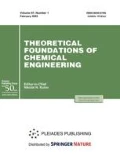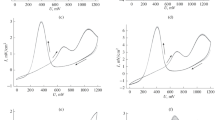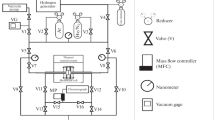Abstract
The possibility of chemical encapsulation of surfaces of technological equipment made of PVC materials into porous H+- or OH–-conducting and hydrogen- or oxygen-producing layers. They consist of activated carbon grafted with ethanolamine derivatives of PVC and aqua complexes H2SO4, NaOH, or KOH and are bridges between electrolyte solutions in reactive electrochemical matrices. With cathodic polarization, the layer becomes a source of hydrogen, and with anodic polarization, it becomes a source of oxygen. The rate of their release into the reaction masses is determined by the magnitude of the current in the matrix.

Similar content being viewed by others
REFERENCES
Tsivadze, A.Yu., Fridman, A.Ya., Voloshchuk, A.M., Morozova, E.M., Sokolova, N.P., Bardyshev, I.I., Gorbunov, A.M., Novikov, A.K., Petukhova, G.A., Polyakova, I.Ya., Titova, V.I., and Yavich, A.A., Electrochemically reactive matrices based on electron-ion conducting and adsorption-active tissues, Russ. J. Electrochem., 2017, vol. 53, no. 1, pp. 39–48. https://doi.org/10.1134/S1023193517010153
Tsivadze, A.Yu., Fridman, A.Ya., Averin, A.A., Shabanov, M.P., Morozova, E.M., Petukhova, G.A., Novikov, A.K., Bardyshev, I.I., Polyakova, I.Ya., Gorbunov, A.M., Titova, V.N., and Yavich, A.A., Formation and properties of electron- and ion-conducting layers of N-substituted PVC derivatives grafted onto active carbon, Prot. Met. Phys. Chem. Surf., 2019, vol. 55, no. 6, pp. 1071–1079. https://doi.org/10.1134/S2070205119050265
Tsivadze, A.Yu., Fridman, A.Ya., Maksimov, A.L., Novikov, A.K., Polyakova, I.Ya., Gorbunov, A.M., Petrukhina, N.N., Shabanov, M.P., Titova, V.N., and Yavich, A.A., A polycomplexone composition: A new-generation reagent for the processing of heavy high-viscosity oil, Universum: Khim. Biol., 2019, vol. 65, no. 11, pp. 45–50.
Tsivadze, A.Yu., Maksimov, A.L., Fridman, A.Ya., Tumanyan, B.P., Novikov, A.K., Gorbunov, A.M., Shabanov, M.P., Kuchinskaya, T.S., and Burykhina, E.S., Processing of oil-tank sludge by hydrothermal dispersion using polycomplexants and amino-acid-salts, Chem. Technol. Fuels Oils, 2020, vol. 56, no. 2, pp. 199–204. https://doi.org/10.1007/s10553-020-01129-3
Tsivadze, A.Yu., Fridman, A.Ya., Morozova, E.M., Sokolova, N.P., Voloshchuk, A.M., Bardyshev, I.I., Gorbunov, A.M., Novikov, A.K., Polyakova, I.Ya., Titova, V.N., and Yavich, A.A., Porous proton- and chloride-ion conducting layers based on ethanolamine derivatives of PVC on the surfaces of fabrics, Russ. J. Phys. Chem. A, 2018, vol. 92, no. 2, pp. 368–372. https://doi.org/10.1134/S0036024418010284
Petterson, R., Polyvinyl chloride use in cooling towers, Proc. Cooling Technology Institute Annual Conference 2016 (Houston, 2016), Houston: Cooling Technology Inst., 2016.
Jemii, H., Bahri, A., Boubakri, A., Hammiche, D., Elleuch, K., and Guermazi, N., On the mechanical behaviour of industrial PVC pipes under pressure loading: Experimental and numerical studies, J. Polym. Res., 2020, vol. 27, p. 240. https://doi.org/10.1007/s10965-020-02222-1
Jain, A., Polyvinyl Chloride Market Share, Forecast Report to 2026, Pune: Value Market Research, 2020.
Shabanov, M.P., Tsivadze, A.Yu., Fridman, A.Ya., Morozova, E.M., Gorbunov, A.M., and Averin, A.A., Layers of active carbon with grafted sodium and potassium glycinate derivatives on the surface of PVC film, Carbon: Sci. Technol., 2018, vol. 10, no. 3, pp. 1–7.
Funding
The study was carried out with financial support from the Russian Foundation for Basic Research within scientific project no. 18-29-24137.
Author information
Authors and Affiliations
Corresponding author
Rights and permissions
About this article
Cite this article
Tsivadze, A.Y., Fridman, A.Y., Titova, V.N. et al. Prospects for Creating H+- or OH–-Conducting and Hydrogen- or Oxygen-Producing Surfaces in a Reaction Apparatus from Polyvinyl Chloride Materials. Theor Found Chem Eng 55, 343–347 (2021). https://doi.org/10.1134/S0040579521030234
Received:
Revised:
Accepted:
Published:
Issue Date:
DOI: https://doi.org/10.1134/S0040579521030234




